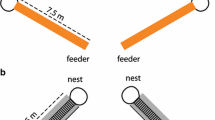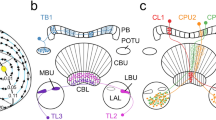Summary
-
1.
To test the colour pattern hypothesis ofE-vector orientation in the honeybee (van der Glas, 1975) menotactic orientation to unpolarized overhead patterns, in which the colours blend in a gradual transition from one to the other (Fig. 2; stimulus field: 17.7°), has been studied by observation of bees dancing on a horizontal comb.
-
2.
When the patterns are of colours of short wavelength, dances are well oriented with relatively small variance but the angle between the indicated feeding place and the sun's bearing is usually transposed by 180° (Fig. 11). Therefore an unpolarized colour pattern evokes directional dances specifically oriented as if the pattern provided a clue to the sun's bearing.
-
3.
In contrast, when the patterns are made up of bee white (including UV) of different brightness levels (with gradual transition between “light” and “dark”), dance orientation is poor. Hence orientation to the coloured patterns cannot be just a response to brightness or a result of differential stimulation of R9 or the other UV receptors in different overhead areas independent of other receptor types.
-
4.
Evidence is given that the oriented response to the experimental overhead short wavelength colour patterns does not indicate that natural colour- and UV patterns in the sky are used.
-
5.
The fact that bees do orientate to unpolarized colour patterns along with previous data on integrational processes between different types of spectral receptors inE-perception (van der Glas, 1975, 1976), are consistent with a perception mechanism for sky polarization by means of colour coding. On the other hand, the result of the bees' transposition by 180° of the angle between the indicated feeding place and the sun's bearing cannot yet be finally interpreted with any current model for celestial orientation.
Similar content being viewed by others
Abbreviations
- PD :
-
percent deviation
- JR :
-
infrared
- RTA :
-
rhabdom transversal axis
References
Batschelet, E.: Statistical methods for the analysis of problems in animal orientation and certain biological rhythms. Washington: Am. Inst. Biol. Sci. 1965
Braitenberg. V.: Patterns of projection in the visual system of the fly. I. The retina-lamina projection. Exp. Brain Res.3, 271–298 (1967)
Brines, J.L., Gould, J.L.: Bees have rules. Science206, 571–573 (1979)
Crawford, B.H., Granger, G.W., Weale, R.A.: Techniques of photostimulation in biology. Amsterdam: North-Holland Publishing Company 1968
Daumer, K., Jander, R., Waterman, T.H.: Orientation of the ghost-crabOcypode in polarized light. Z. Vergl. Physiol.47, 56–76 (1963)
Edrich, W., Neumeyer, C., Heiversen, O. von: “Anti-sun orientation” of bees with regard to a field of ultraviolet light. J. Comp. Physiol.134, 151–157 (1979)
Frisch, K. von: Gelöste und ungelöste Rätsel der Bienensprache. Naturwissenschaften35, 38–43 (1948)
Frisch, K. von: The dance language and orientation of bees. Cambridge, Mass.: Harvard University Press 1967
Glas, H.W. van der: Polarization induced colour patterns: a model of the perception of the polarized skylight by insects. I. Tests in choice experiments with running honeybeesApis mellifera. Neth. J. Zool.25, 476–505 (1975)
Glas, H.W. van der: Polarization induced colour patterns: a model of the perception of the polarized skylight by insects. II. Experiments with direction trained dancing beesApis mellifera. Neth. J. Zool.26, 383–413 (1976)
Glas, H.W. van der: Mechanisms of E-vector orientation in the honeybee. Thesis, State University of Utrecht (1978)
Grundler, O.J.: Elektronenmikroskopische Untersuchungen am Auge der Honigbiene (Apis mellifica). I. Untersuchungen zur Morphologie und Anordnung der neun Retinulazellen in Ommatidien verschiedener Augenbereiche und zur Perzeption linear polarisierten Lichtes. Cytobiologie2, 203–220 (1974)
Heiversen, O. von: Zur spektralen Unterschiedsempfindlichkeit der Honigbiene. J. Comp. Physiol.80, 439–472 (1972)
Heiversen, O. von, Edrich, W.: Der Polarisationsempfänger im Bienenauge: ein Ultraviolettrezeptor. J. Comp. Physiol.94, 33–47 (1974)
Hess, P.: Die spektrale Energieverteilung der Himmelstrahlung. Gerlands Beitr. Geophys.55, 204–220 (1939)
Jander, R., Waterman, T.H.: Sensory discrimination between polarized light and light intensity patterns by arthropods. J. Cell. Comp. Physiol.56, 137–160 (1960)
Jander, R., Daumer, K., Waterman, T.H.: Polarized light orientation by two Hawaiian decapod cephalopods. Z. Vergl. Physiol.46, 383–394 (1963)
Kaiser, W., Liske, E.: Die optomotorischen Reaktionen von fixiert fliegenden Bienen bei Reizung mit Spektrallichtern. J. Comp. Physiol.89, 391–408 (1974)
Kirschfeld, K.: Optomotorische Reaktionen der Biene auf bewegte „Polarisations-Muster“. Z. Naturforsch.28c, 329–338 (1973)
Menzel, R., Snyder, A.W.: Polarised light detection in the bee,Apis mellifera. J. Comp. Physiol.88, 247–270 (1974)
Ribi, W.A.: The first optic ganglion of the bee. I. Correlation between visual cell types and their terminals in the lamina and medulla. Cell Tissue Res.165, 103–111 (1975)
Ribi, W.A.: Do the rhabdomeric structures in bees and flies really twist? J. Comp. Physiol.134, 109–112 (1979)
Snyder, A.W.: Polarisation sensitivity of individual retinula cells. J. Comp. Physiol.83, 331–360 (1973)
Sommer, E.W., Wehner, R.: The retina-lamina projection in the visual system of the bee,Apis mellifera. Cell Tissue Res.163, 45–61 (1975)
Stavenga, D.G., Beersma, D.G.M.: Formalism for the neural network of visual systems. Biol. Cybern.19, 75–81 (1975)
Strausfeld, N.J.: The representation of a receptor map within retinotopic neuropil of the fly. Verh. Dtsch. Zool. Ges., pp. 167–179. Stuttgart: Gustav Fischer Verlag 1979
Verheijen, F.J., Wildschut, J.T.: The photic orientation of hatchling sea turtles during water finding behaviour. Neth. J. Sea Res.7, 53–67 (1973)
Wehner, R.: Structure and function of the peripheral visual pathway in Hymenoptera. In: Neural principles in vision. Zettler, F., Weiler, R. (eds.), pp. 280–333. Berlin, Heidelberg, New York: Springer 1976
Wolf, E.: Über das Heimkehrvermögen der Bienen. II. Z. Vergl. Physiol.6, 221–254 (1927)
Author information
Authors and Affiliations
Additional information
I am indebted to my wife Magda van der Glas-Castro, to R. Jacobs, J. Tulleneers, R. Vanwerde and G.M.J. Castro for their assistance in the experiments, to I. Daniels, R. Vanwerde and D. Blevi for the construction of the equipment, to I. Dewispelaere, M. Ieven and G. Vanparrijs for the drawings and to Y. Celis for typing the manuscript. I gratefully acknowledge Prof. T.H. Waterman, Drs. J. Tinbergen and Dr. D.G. Stavenga for their helpful suggestions concerning the manuscript, and Dr. T. Pattison for correcting the English.
Rights and permissions
About this article
Cite this article
van der Glas, H.W. Orientation of bees,Apis mellifera, to unpolarized colour patterns, simulating the polarized zenith skylight pattern. J. Comp. Physiol. 139, 225–241 (1980). https://doi.org/10.1007/BF00657084
Accepted:
Issue Date:
DOI: https://doi.org/10.1007/BF00657084




